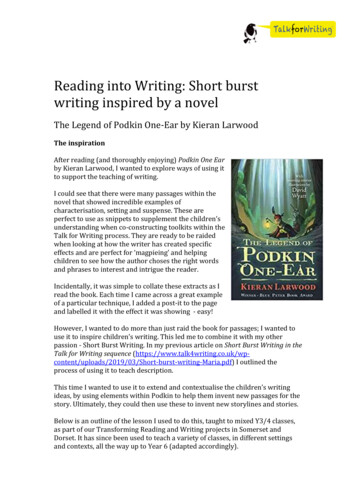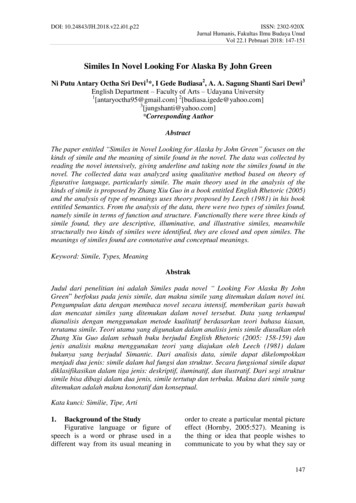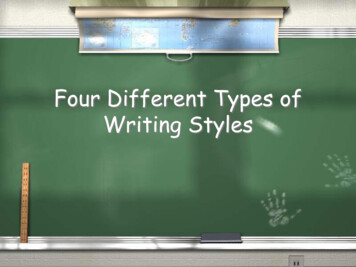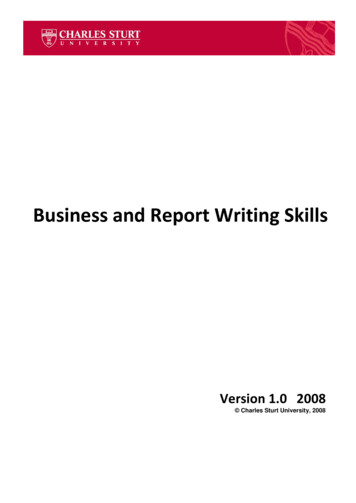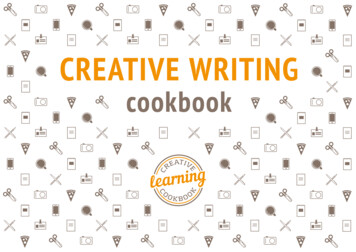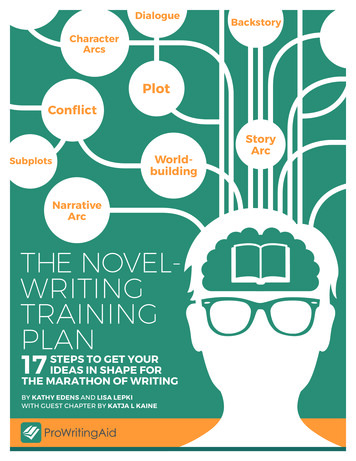
Transcription
ldingSubplotsNarrativeArcThe NovelWritingTrainingPlan17steps to get yourideas in shape forthe marathon of writingProWritingAidBy Kathy Edens and Lisa Lepkiwith guest chapter by Katja L rc
IntroductionSo you are ready to write your novel. Excellent. If you write 500 wordseach day, in 100 days, you’ll have 50,000 words. That’s a book in about3 months. Totally do-able. Or maybe you are planning to go full-tilt andtake part in National Novel Writing Month (NaNoWriMo) where the goalis to get your first draft done in 30 days. Go for it!Think of this book as your training regimen. Trying to run a marathon without taking the time toprepare your body would be hugely difficult. Maybe not impossible, but certainly harder than ifyou had spent the time getting your muscles ready. Similarly, it’s not impossible to write a bookwithout spending some time in advance preparing your brain for the task, but thinking throughsome of the essential elements of your story will make the whole process easier.Give yourself a couple weeks before you start writing to think through your narrative, plan out yourkey plot points, flesh out your characters, and begin to build your world. This way, when you beginyour writing journey, you will have a map to follow along the way.Turn the page, and let’s get started!contentsChapter 1: Start with Your Original Idea3Chapter 2: How to Construct a 3D Main Character5Chapter 3: How to Create Your Story’s World8Chapter 4: How to Draft Your Story Arc11Chapter 5: How to Create a Compelling Character Arc13Chapter 6: Drafting Your Plot16Chapter 7: How Characters Transform20Chapter 8: How to Use Subplots to Bring Your Whole Story Together23Chapter 9: Avoid These Plot Pitfalls25Chapter 10: Choosing Your POV—It’s Not as Easy as You Think28Chapter 11: Creating Compelling & Evocative Scenes31Chapter 12: Types of Conflict34Chapter 13: Using Titillating & Captivating Dialogue37Chapter 14: Weave Backstory Carefully & Sparingly39Chapter 15: Research is Not a Dirty Word Really!42Chapter 16: How to Tie Everything Together aka How to Write a Killer Ending44Chapter 17: The Drafts Your Novel Needs (and Why You Probably Won’t Use One Word of Your First Draft) 46ConclusionAppendix: About ProWritingAidProWritingAidProWritingAid52532
chapter 1 start with your original ideaIn life, as in writing, there are several questions which continue to defy a single, unified opinion:Which came first: the chicken or the egg?Or the question for most writers is: Which came first: the plot or the characters?Ask 20 authors how they begin their stories—either by identifying the main character or the plotfirst—and the one certainty is you won’t get the same answer 20 times.Regardless of whether you woke up one morning with an incredible plot twist for your novel, ora fully-formed character started speaking in your mind, everyone needs a starting point for theirwriting. The key is to realize that, in the best stories that resonate most with readers, plot andcharacter are intrinsically interwoven.It all starts with an ideaThe first thing you’ll need is an original idea. What kind of story is it? Aromance? Suspenseful thriller? A comedy or tragedy? Think about a movie.You wouldn’t cast parts without knowing what the movie is about, right?Imagine casting Liam Neeson in a Big Momma’s House type film. You wouldbe waiting for his daughter to get kidnapped the whole time!Some characters just don’t work with the type of novel you’re writing. Youneed to know a little bit about where your story is going in order to decidewhat traits you need in a protagonist and an antagonist. If your story culminates in a life-or-deathsituation, you need someone who can handle the outcome and your reader needs to understandhow and why they can.An adventurous external plot requires a character whose unexpected growth is rewarding and lifealtering. You see this in the unlikely heroes of such stories as Lord of the Rings, The Truman Show,Harry Potter, Buffy The Vampire Slayer and The Martian.But how do you find that nuggetof an idea to start with?A lot of authors start with a “what if” scenario to form a general idea of the plot. “What if there’sa scrawny little boy with glasses who just found out he’s a wizard capable of magic?” Imagine JKRowling sitting on a crowded train when the idea of a boy who didn’t know he was a wizard poppedinto her mind. When he first conceived Lord of the Flies, William Golding must have wondered “Whatwould happen if a group of school boys were stranded on an island with no adult supervision?”This is where “the plot thickens.” Once you have that initial idea, your brain immediately starts towonder what kind of person would work best in your “what if” scenario. You start to merge the plotdetails with the character traits that can generate the most internal conflict for your protagonist.Imagine a character who would hate being put into the situation you’ve created. And imagine howyour plot might twist and turn to escalate the pressure and the tension for your main character.Or say you’ve thought of this excellent character who’s suddenly fully formed in your mind. You canplay the “what if” game with characters, too. Try to imagine what would happen to your character ifhis or her worst fears were realized?ProWritingAidProWritingAid3
For example, you have a mental picture of a devoted wife and mother who has structured her lifearound the needs and wants of her family. You can see her, you know what she sounds like and whather deepest fears and desires are. Now, what if she found out her husband and children were notwho she thought they were?Your characters might end up hijacking your plot, taking it over and making it their own. But that’sOK because you want a story with the characters and plot so finely intertwined that you can’t haveone without the other.Now that you have your great idea, where doyou turn next?It’s all too easy to jump into writing a novel with an excellent storyline, only to have it peter outhalfway through because you don’t know where it’s going, or because you’ve dug your charactersinto a hole without first planning how they were going to get out of it.Alternatively, you might create incredibly relatable characters who emote beautifully all over thepage, but find that you can’t quite figure out what should happen to them. So make a plan.If you’re already an outliner by nature, this will warm your soul. If the idea of planning ahead makesyou nervous, well, stick with us anyway. It’s not that bad—truly.There are 3 things you need to know before you start:1Draft your characters. You need to know who your protagonist is and what he or she wantsmost and fears most. While your character is certainly going to become much more solid as youwrite, you should still know the basics - likes and dislikes, any quirky little personality traits, backstory,his or her voice, and what motivates him or her. We’ll look in more depth at crafting real-life, fullyformed characters in the next chapter, so keep reading.2Draft your story’s world. You want a dynamic setting as the backdrop to your story. Knowingwhere (and when) the action takes place drives characters’ decisions. Does your story take placein war-torn France during WWII? Or does it take place in an imagined universe very different to ourown? The “where and when” help lead your characters in decision-making based on the kind ofsolutions available to them. You wouldn’t set a novel in the early 1900s only to discover that yourprotagonist needs new technology to help solve a problem. We’ll talk more about creating yourstory’s world in Chapter 3.3Define your story arc. You might consider this the map that guides your main characteralong the path to your desired end. The key is to realize that a map is not set in stone. Sometimeswhen you start out on a journey, you take some interesting side trips along the way, but youreventual ending point is still known. Your characters can deviate from the map when you comeacross a great plot twist, but you should have a general idea of where you’re headed and how theindividual character threads and supporting subplots tie together in the end. This will give you anidea of where things need to shake out in each chapter to keep the momentum moving forwardand your characters evolving. More on story arc in Chapter 4.What’s next?You probably feel ready to burst onto the page, but we’ve only just done the equivalent ofstretching our muscles. Take a break if you need it, then keep reading. In the next chapter we laythe groundwork for creating three-dimensional, relatable characters that make your readers laugh,cry, and want to be their best friends.ProWritingAidProWritingAid4
chapter 2 how to constructa 3d main charcterHave you ever read something and about 50 pagesinto it, you’re just not feeling the main character?You’re either not invested in her conflict or she’skind of boring.Or worse, has an agent or editor to whom you’vesubmitted your work ever commented that yourmain character (MC) is one-dimensional?Now think about the latest book you couldn’tput down. You could hardly wait to find out whathappened to the MC. You just “got” her; she wasrelatable and you understood why she did thethings she did.She was obviously a three-dimensional MC. Butwhat does that mean?It begins with acharacter, usually, andonce he stands up onhis feet and begins tomove, all I can do istrot along behind himwith a paper and penciltrying to keep up longenough to put downwhat he says and does.William FaulknerHow to Identify the Deeper Dimensions of an MCThis is where a little forethought and planning will help you create a multi-dimensional MC.If you’re an incredibly intuitive person, you may be able to give your character three dimensions asyou write, but most of us need to plot a character’s dimensions to show real depth. Let’s face it. Reallife is three-dimensional. If we could predict how people will respond to situations, it would be somuch easier to figure out how to ask the difficult questions.Life is messy. Emotions are messy. Real life unfolds and unravels rather unpredictably. So should yourcharacters. Consider the following three dimensions of character development:The 1st DimensionThis is what we see on the outside. These are the surface traits, the little personality quirks and habitsthat characters have. This may be the real person or it may just be their social mask that they presentto the world. Without any other dimensions, we’ll never know how authentic it is. The supportingcast in our stories are one-dimensional. We don’t need to know what’s behind their façade. It’s notimportant to your readers to know what kind of childhood the waiter at the restaurant had. But youdo need to know that about your MC. That’s where weaving in the other dimensions helps flesh outyour characters.One thing to note: avoid cliché quirks and tics for your main characters, and even in your supportingcharacters. The grumpy old man who screams at the kids to get off his lawn or the two-facedpolitician who preaches family values to the public yet has a mistress or two on the side—all of theseclichéd character traits have been done to boredom and back. You definitely do not want to giveyour MC quirks that are tired or even too quirky.The 2nd DimensionThis is what we see on the inside and where backstory comes into play. What is it about yourMC’s childhood that causes him to freeze up whenever someone gets too close? What are herinner conflicts or unfulfilled dreams that cause her to respond in certain ways? Everyone has fearsProWritingAidProWritingAid5
and weaknesses, resentments and inclinations that underlay the outer face they show the world.Sometimes that’s a smokescreen to throw the reader off the path. When readers understand why anMC reacts the way he or she does, you’ve created empathy for that character. And the more empathyyou can create for a character, the more readers will invest in reading.The 3rd DimensionThese are the character’s beliefs that lead to action and behavior. This is their moral substance. AnMC’s character isn’t defined by their backstory or their inner conflict, but rather by the decisions theymake when facing a moral situation. You may have been angry enough to smack someone in the facea time or two, but you decided not to. Why? Because of your moral character. That decision defineswho you are. Now take a character who has a similar backstory and inner conflicts, but who didpunch someone in the face. You’ve now created a completely different-dimensioned character.Hopefully you can see how each of the dimensions informs the others, but that they’re distinct andunique. The 1st and 2nd dimensions don’t necessarily dictate the 3rd. This is how you layer yourcharacter to create depth. Think of the layers of an onion. The outer layers aren’t transparent. Youcan’t see through one to what’s underneath. You need to peel back to find what’s at the core.6 Tips for Creating 3D CharactersThese tips will help you flesh out some multi-dimensional depth1. Let them surprise you.A shy person who’s always timid suddenly finds himself flirting with an attractive stranger onthe train. An experienced businessman gets tongue-tied when facing a big presentation orspeech. Be open to unexpected reactions in your MC. Don’t restrict your characters to actinga certain way all the time. Punch things up. Everyone acts out of character periodically; imbueyour MC with a little “out of character” action and then hone in on the reason that allowedthem to be different this time: loyalty, inner strength, love, fear, anger, anything really.2. Let them search for a purpose.We all—at least most of us—search for a greater purpose in our lives. Let your MC reach for one.When faced with a hard decision, let your character decide to take a different path because itbrings her closer to her beliefs or dreams. Whether or not this turns out to be a good or baddecision is another story. Give your MC a sense of destiny and see where it takes her.3. Let inner feelings be expressed physically.When we feel good about ourselves, we might dress a little differently or spend more time onan up-do to make our outer appearance match the way we feel inside. Instead of using innerdialogue to tell us your main character is trying to fight off a wave of insecurity, show us thefingernails bitten and torn, ragged and bleeding. Trust your reader to be able to recognize andinterpret the physical actions of your characters4. Use conflicting emotions.You know you want that third cookie before dinner, but you also really want to lose the last 10pounds you’ve been working on. Human beings are naturally conflicted about a lot of things. Letus see that your MC is conflicted about her strongest beliefs. She’ll be much more human for it.5. Use real-life emotions.You’ve experienced emotions in life. It may not have been the same scenario as your MC isProWritingAidProWritingAid6
facing, but you can draw from your life experiences to inform your writing about what yourcharacter is feeling. Did you have a beloved pet die when you were a kid? Channel thoseemotions into your MC when something bad happens. The details aren’t important; thehuman emotions of losing something cherished are.6. Use dialogue to illustrate deceit or create power dynamics.Often what comes out of your MC’s mouth is quite different from what they are really thinking.Your reader has the unique ability to read your MC’s thoughts and see whether they are beinghonest or manipulating the situation. We’ll take a closer look at dialogue in Chapter 13.Take-AwaysHuman beings are conflicted, emotional creations that work on all three dimensions. They are thesum of all their parts, and that’s the essence you want to convey when creating your MC.They are a complicated mess of optimistic dreams and shameful secrets.It’s your job to show your readers these dimensions, creating engaging and compelling charactersthat are complex, frightening, endearing, and, most of all, empathetic.ProWritingAidProWritingAid7
chapter 3 how to createyour story’s worldNo matter what genre you write in, you need to build a world for your story. Every writer needs tobuild a world so that your readers can have a placeholder to figure out the context in which yourstory is set.If you’re writing a current-day story, you should know where it is set and what’s happening in theworld around your main characters. Imagine the movie Forrest Gump without the political andcultural wrangling. Without that story’s world, Forrest would have been a seriously flat character.If you’re writing science fiction or supernatural stories, world-building is extremely important.The more fantastical your setting, the more time you’ll need to spend developing it. Consider TheHobbit and The Lord of the Rings trilogy—even Star Wars. For those stories to come alive, the maincharacters’ experiences had to be set in those rich and textured worlds.Why You Should Build Your WorldYour characters need a place for the story to unfold. It can’t happen in limbo. A movie or a playwithout a set and background would be hard to follow. It gives you the context in which thecharacters are placed in time and space and helps your reader connect to your story. Even if theworld looks like your own, it’s still essential to build it for your audience.In many ways, the world functions like another character, especially for science fiction and fantasy.Think about a novel you’re currently reading. Can you picture his neighborhood or what hishome looks like—majestic and imposing or squashed and run-down? Metropolitan, suburban orcountryside? Do you have an image in your mind of her office, her car or her local bar? If you canvisualize these things, the author has done a good job of setting up their world.Sometimes the specific setting is essential to the story’s narrative arc. Imagine if To Kill a Mockingbirdhad not taken place in the Deep South during the Great Depression when civil rights weren’t on thehorizon. Or if the book Sarah’s Key was not set in both WWII and current-day scenarios, would theending have been as emotional?The more intimately you know your world and how it affects your story, the richer and deeper yourwriting will be.Develop the Specific and the GeneralStart with the general. Is it set in modern day, a historical period, or on an alien planet? This willguide how deep you need to go in world-building.If your setting is current day, you only need to describe the location and the setting for each scene inyour story. Your audience will have an understanding of modern day New York, for example, but youstill need to build a specific setting in New York, complete with noisy neighbors, a tiny apartmentor a local coffee shop. But if your story is set in history or in a different culture from your own, you’llneed to research cultural norms, economics, dress, and even technology so that your world ringswith authenticity.In a new fantastical world, you need to build the entire thing from the ground up:1. Think about basic infrastructure.What do people eat? Who takes care of public utilities like water, sewage, electricity—or are thereeven public utilities? You need to create an entire society and its underlying economy.ProWritingAidProWritingAid8
2. Why is your story’s struggle happening now?When all hell breaks loose in your story’s world and your character must respond, you need to knowwhat led up to those events. Is it because of something that happened 20 years ago or somethingthat’s going to happen 20 hours from now?3. What about diversity?Our world—or any world for that matter—has a diverse mix of people who don’t hold the sameopinions. Don’t create a world where everyone believes in the government or interprets religion inthe same manner. No two members of any society will think exactly the same way.4. Use all five senses to create your world.Nothing says more about a story’s world than what its garbage smells like or how it looks after a hardrain. Whatever world you create, what do its transportation vehicles sound like as they roll past or flyoverhead? Create a sense of place with sensuous information.How to Build Your WorldIf you’re looking for a way to get started, try these tips:1. Read, read, read.Read works by other authors where they’ve created full and rich worlds for their stories. TheHarry Potter books are a great example of how a new world informs the story and compelsHarry to act in certain ways.2. Watch movies.Movies are also a great way to get inspiration for your own work. Watch supernatural flicks oreven animated movies like Avatar to see how someone else has constructed a new world.3. Draw a map.Use a big sheet of paper and plot out what your world looks like. Don’t aim for a perfect drawing,just something to show you where everything is located and how your character can get around.4. Outline your world’s details.What technology do they use? What is on the cusp of being invented? What types of plantsand animals live in your world? How are the people different from yourself? How do mostpeople survive or make their living?5. Try on someone else’s world.Take parts of worlds created by others and combine them in a different way. Then give it a plottwist and you’ve created a new world, one in which your characters can grow and develop.When to Stop World-BuildingYou don’t need to write an encyclopedia on your newly created world. Your reader just needs toknow the basics and a few of the specifics. Don’t inundate them with tidbits of information aboutyour world if those tidbits don’t move your story forward.Your world should inform your characters in ways that provide movement. If you put in a hugesection about flora and fauna, it better be part of the plot line in chapters to come, somethingProWritingAidProWritingAid9
your reader needs to know. Your world may play a central role in your character’s developmentand growth, but it should never become the main character. Let it help you develop your maincharacter’s eventual denouement, but never take it over.If you’ve written so much about your world that you haven’t even started on the story yet, it’s timeto stop. You can always flesh it out in more detail as it becomes necessary.My World is Built. Now What?You’ve patiently put in the work fleshing out your MC and constructing your story’s world. It’s time tomap out your story arc. This step would be daunting without any prior training, but by now you’ll behitting the ground running. Let’s go!ProWritingAidProWritingAid10
chapter 4 how to draft your story arcThe story arc (sometimes called the narrative arc) is a more poetic way of saying that each storymust have a beginning, a middle, and an end—or Act One, Act Two, and Act Three. This has been theguiding template of stories since the ancient Greeks started writing them, and holds true whetheryou’re writing fiction or non-fiction.Where authors fall down on story arc is when nothing much happens to the main character by theend of the book. They haven’t been tested in some profound way.Story Arcs and Character ArcsYour story arc and character arc should be melded together in such a way that you’re not sure whereone begins and the other ends. As your main character is tested, endures, and grows in a climacticway throughout the story arc, she naturally changes as a character by the end of the story.You can’t have a story arc without a character arc.Character is plot,plot is character.We’ll get to character arc in the next chapter, but for now,know that both play off each other.In a Word, What’s Important: ActionF. Scott FitzgeraldYour main character must be confronted by action—danger, threats, seduction, tests of bravery,moral dilemmas, or physical or emotional assault, to name a few. Consider the story arc of The GreatGatsby. Gatsby starts out as a poor man who falls in love with a rich girl. He works hard to changehis circumstances and win the girl. Then there’s the climactic scene and the denouement. Everyonechanges to a degree by the end.A good story starts with a bang or a hook in Act One, something to get the reader’s attention, andquickly accelerates to more action. Act Two, or the middle, is intertwined throughout with scenes ofrising drama, suspense, or intensity and scenes of calm deliberation to let your readers catch theirbreath. Act Three culminates in a climax where the character is changed in some fundamental way,and then the tension falls back down until you’ve reached a satisfactory closure.What Does a Story Arc Look Like?Story arcs look like a giant bell curve with the story starting at ground zero and rising, rising, rising,until it hits the climax point at the height of the curve. Then the arc starts to gradually drop backuntil you’ve hit level ground essor ingAid11
Or it can look like a pyramid where each block is a scene that builds up the pyramid until the apexand then slowly comes down the other side until you’re at the denouement.If you’re having problems identifying your story arc, graph your story on paper to ensure that theaction rises, falls a little, rises even more, falls a slight bit, and keeps rising until reaching the climax.You might end up with something that looks like a bell curve, or you might end up with somethingthat looks like a stock market index. Either way, your action should consistently raise the tension orthe stakes until it reaches the peak.Your Story Arc is Your Guide to PlottingStory arc deals with the overall layout of your story, how it is broken up into chapters and scenes,what is the conflict and climax, and what is the final resolution. Plot is the specific series of eventsthat make up your story.You need to have the big picture figured out first (the story arc) before you can start plotting howyou’ll get there. Each point in your plot occurs in a particular order and relates in some way to theother plot points.We’ll talk more about plotting in Chapter 6, but for now, just remember that your story arc and plotwork together to create the DNA of your story.How to Create Your Story ArcNigel Watts wrote in his book Writing a Novel and Getting Published that yourstory arc should follow these eight points:1. Stasis5. Critical ChoiceThis is the current situation you find yourmain character in.This is when your MC chooses what path totake and confronts the obstacles.2. Trigger6. ClimaxThis is an inciting event that changes thecourse for your main character.The critical choice results in the climax, thepeak of tension in your story.3. Quest7. ReversalThe trigger results in a quest for your maincharacter to achieve a goal.Your character is changed in some way.4. SurpriseThe story ends with a satisfactory closure.8. ResolutionThese are complications that prevent yourmain character from achieving his goal.This is a good road map to help you generate the higher level of story arc, where you want the storyto go, and how things will change.What’s Next?Story arc and character arc go hand-in-hand. When you’ve got your story arc in place, it’s timeto work on your character arc. This is the groundwork that you’ll build upon until your plot andcharacter development seamlessly intertwine.ProWritingAidProWritingAid12
chapter 5 how to create a compellingcharacter arcYou have a story arc, and now you need a character arc. But what exactly is a character arc, and howdo you create one?Defining a Character ArcThe standard definition of a character arc is how your main character changes over the course ofyour story.The most common form of character arc is the “Hero’s Journey”. An ordinary person receives a call toadventure and, at first, he or she refuses that call. There’s usually a mentor who helps the hero acceptor learn how to attempt the adventure. Think of Yoda in Star Wars.On the Hero’s Journey, the main character goes through many tests, trials, friends and enemiesas he or she prepares for the final challenge. The journey culminates in the hero facing down theopposition where he finally acquires his goal, whether it’s a golden chalice or the princess’s hand.There’s a sort of resurrection where the hero comes from the brink of death or destruction to ahigher form of being. Then the main character finally returns home—a hero.There’s More to the Character ArcIt’s important to note that there’s more out there than just the good guy or gal who’s transformedby the end of the story. Not all characters undergo some major transformation. In some cases, yourmain character will grow, but not transform.In fact, most character arcs can be simplified to fit into three different, but sometimesoverlapping, categories:1. The Change Arc (aka the Hero’s Journey)Probably the most common, or at least the most recognizable. By the end of thetale, the main character has conquered and becomes a usually unlikely hero.Some examples include: Katniss Everdeen’s rise from poor hunter to revolutionary hero by the end ofThe Hunger Games. Frodo Baggins in The Fellowship of the Ring begins as an eccentric little hobbitwith an ordinary life in the Shire. No one would have expected him to overcome so many obstaclesand throw the ring into Mount Doom. M ichael Corleone in The Godfather by Mario Puzo. (Remember, the hero is not necessarily a goodguy!) Just home from World War II, Michael wants nothing to do with the family business, but anassassination attempt on his father forces him to take action and sends him down the path towardbecoming the ruthless leader of New York’s most powerful mafia.2. The Growth ArcProWritingAidThis is where your main character becomes a better version of who he orshe really is. Another version of the Growth Arc is a Shift Arc where the maincharacter shifts his opinion or perspective about a certain situati
If you’re already an outliner by nature, this will warm your soul. If the idea of planning ahead makes you nervous, well, stick with us anyway. It’s not that bad—truly. there are 3 things you need to know before you start: 1 draft your characters. You need to know who your pro
